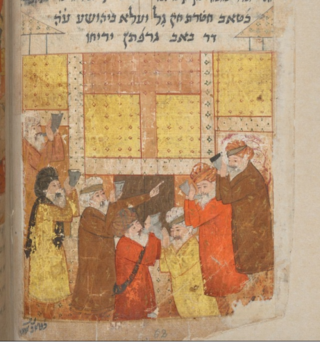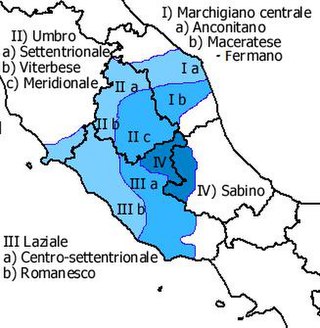
Ancona is a city and a seaport in the Marche region of Central Italy, with a population of around 101,997 as of 2015. Ancona is the capital of the province of Ancona and of the region. The city is located 280 km (170 mi) northeast of Rome, on the Adriatic Sea, between the slopes of the two extremities of the promontory of Monte Conero, Monte Astagno and Monte Guasco.

Judeo-Persian refers to both a group of Jewish dialects spoken by the Jews living in Iran and Judeo-Persian texts. As a collective term, Judeo-Persian refers to a number of Judeo-Iranian languages spoken by Jewish communities throughout the formerly extensive Persian Empire, including the Mountain and Bukharan Jewish communities.

Jewish languages are the various languages and dialects that developed in Jewish communities in the diaspora. The original Jewish language is Hebrew, supplanted as the primary vernacular by Aramaic following the Babylonian exile. Jewish languages feature a syncretism of Hebrew and Judeo-Aramaic with the languages of the local non-Jewish population.

Judeo-Arabic dialects are ethnolects formerly spoken by Jews throughout the Arab world. Under the ISO 639 international standard for language codes, Judeo-Arabic is classified as a macrolanguage under the code jrb, encompassing four languages: Judeo-Moroccan Arabic (aju), Judeo-Yemeni Arabic (jye), Judeo-Iraqi Arabic (yhd), and Judeo-Tripolitanian Arabic (yud).
Judeo-Italian is an endangered Jewish language, with only about 200 speakers in Italy and 250 total speakers today. The language is one of the Italian languages and one of the Jewish Romance Languages. Some words have Italian prefixes and suffixes added to Hebrew words as well as Aramaic, roots. All of the language's dialects except one are now extinct.
Yevanic, also known as Judaeo-Greek, Romaniyot, Romaniote, and Yevanitika, is a Greek dialect formerly used by the Romaniotes and by the Constantinopolitan Karaites. The Romaniotes are a group of Greek Jews whose presence in the Levant is documented since the Byzantine period. Its linguistic lineage stems from the Jewish Koine spoken primarily by Hellenistic Jews throughout the region, and includes Hebrew and Aramaic elements. It was mutually intelligible with the Greek dialects of the Christian population. The Romaniotes used the Hebrew alphabet to write Greek and Yevanic texts. Judaeo-Greek has had in its history different spoken variants depending on different eras, geographical and sociocultural backgrounds. The oldest Modern Greek text was found in the Cairo Geniza and is actually a Jewish translation of the Book of Ecclesiastes (Kohelet).
Judaeo-Portuguese, Jewish-Portuguese or Judaeo-Lusitanic, is an extinct Jewish language or a dialect of Galician-Portuguese written in the Hebrew alphabet that was used by the Jews of Portugal.
Judaeo-Romance languages are Jewish languages derived from Romance languages, spoken by various Jewish communities originating in regions where Romance languages predominate, and altered to such an extent to gain recognition as languages in their own right. The status of many Judaeo-Romance languages is controversial as, despite manuscripts preserving transcriptions of Romance languages using the Hebrew alphabet, there is often little-to-no evidence that these "dialects" were actually spoken by Jews living in the various European nations.
Judeo-Shirazi is a variety of Fars. Some Judeo-Shirazi speakers refer to the language as Jidi, though Jidi is normally a designation used by speakers of Judeo-Esfahani. It is spoken mostly by Persian Jews living in Shiraz and surrounding areas of the Fars Province in Iran.

Italo-Western is, in some classifications, the largest branch of the Romance languages. It comprises two of the branches of Romance languages: Italo-Dalmatian and Western Romance. It excludes the Sardinian language and Eastern Romance.

]
Baghdad Jewish Arabic or autonymhaki mal yihud or el-haki malna is the variety of Arabic spoken by the Jews of Baghdad and other towns of Lower Mesopotamia in Iraq. This dialect differs from the North Mesopotamian Arabic spoken by Jews in Upper Mesopotamian cities such as Mosul and Anah. Baghdadi and Northern Mesopotamian are subvarieties of Judeo-Iraqi Arabic.
Judeo-Yemeni Arabic is a variety of Arabic spoken by Jews living or formerly living in Yemen. The language is quite different from mainstream Yemeni Arabic, and is written in the Hebrew alphabet. The cities of Sana'a, Aden, al-Bayda, and Habban District and the villages in their districts each have their own dialect.

Carciofi alla giudìa is among the best-known dishes of Roman Jewish cuisine. The recipe is essentially a deep-fried artichoke, and originated in the Jewish community of Rome, giudìo being the term for Jew in the Romanesco language. It is a speciality of the Roman Ghetto, where it is served by Jewish restaurants in the springtime. In English the dish is usually referred to with the standard Italian spelling carciofi alla giudea; this spelling may be found in Italian sources as well, but the Roman dialect name is much more commonly used.
Judeo-Tripolitanian Arabic is a variety of Arabic spoken by Jews formerly living in Libya.
Judeo-Tunisian Arabic, also known as Judeo-Tunisian, is a variety of Tunisian Arabic mainly spoken by Jews living or formerly living in Tunisia. Speakers are older adults, and the younger generation has only a passive knowledge of the language.

The Central-Northern Latian dialect is an Italian dialect belonging to the Central Italian dialects, of which it represents the southern offshoot.
Judeo-Gascon is a sociolect of the Gascon language, formerly spoken among the Spanish and Portuguese Jews who settled during the 16th century in the cities of Bordeaux, Bayonne and in the south-west part of Landes of Gascony (most notably in Peyrehorade and Bidache. Judeo-Gascon, as Judeo-Provençal, the other major Jewish sociolect of Occitan, is now practically extinct.
Judeo-Algerian Arabic also known as Algerian Judeo-Arabic is a Judeo-Arabic dialect based on Algerian Arabic. Today it is nearly extinct with only a few elderly speakers remaining. The language has a large amount of historical literature. It contained influence from several dialects of Arabic as well as from Hebrew and Aramaic.






